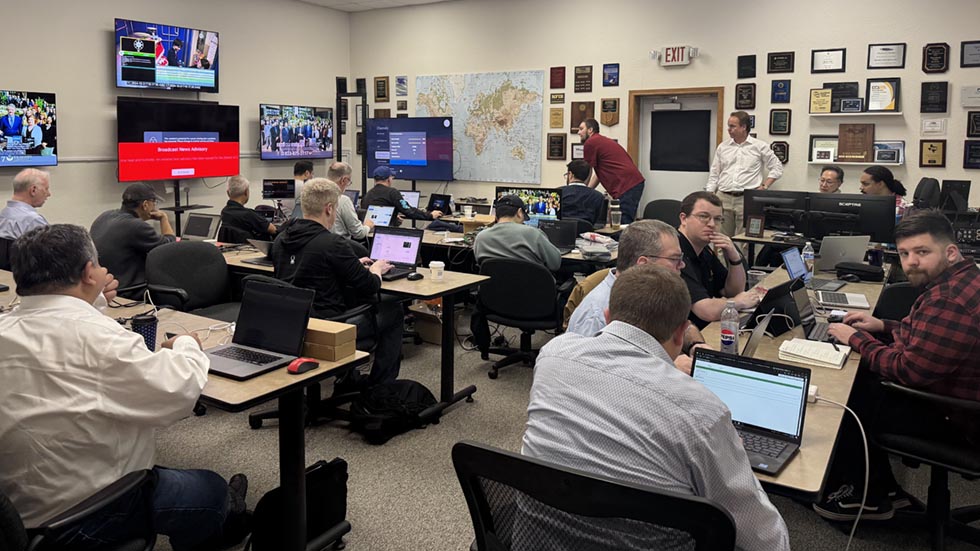Heartland Video Systems Hosts ATSC 3.0 Interoperability Test
The third annual gathering focused on signal signing, HDR, Dolby Atmos and enhanced accessibility

PLYMOUTH, Wisc.—More than 50 organizations from around the world gathered at the headquarters of Heartland Video Systems here Oct. 29-31 to focus on ATSC 3.0 interoperability with an emphasis on signal signing, high dynamic range video, Dolby Atmos audio and enhanced accessibility features.
“As the broadcasting industry embraces the future with NextGen TV, interoperability and innovation are more critical than ever,” HVS president Dennis Klas said. “Hosting this event at our state-of-the-art ATSC 3.0 lab underscores HVS’s commitment to driving technological advancements that will redefine broadcast. The progress made in testing signal signing across platforms using both ROUTE and MMT protocols is another significant step forward to ensure secure and authentic broadcast signals.”
The plugfest, the third annual HVS-hosted 3.0 interoperability event, gave broadcasters, consumer electronics manufacturers and broadcast equipment providers the opportunity to test, validate and refine the latest 3.0 features. Thousands of tests across various equipment combinations verified compatibility and performance in real-world scenarios, HVS said.
The event revealed significant progress on cross-platform signal signing. Participants tested both the ROUTE and MMT protocols. Tests of the former showed ROUTE (Real-Time Object Delivery Over Unidirectional Transport) signing to be successfully verified. MMT signing tests revealed areas needing improvement.
Various HDR formats, including HLG, HDR10, Dolby Vision and HDR10+, as well as combinations of the same, and 5.1.4 Dolby Atmos audio were tested with the goal of enabling cinema-quality, immersive home entertainment.
The event also saw tests of enhanced accessibility features to verify consumer device support for AC-4 dialog enhancement, descriptive audio and multiple caption tracks. Jim Starzynski, director and principal audio engineer at NBCUniversal, and Charles Bronson, a video and audio broadcast and live-streaming solutions architect, ensured compatibility, enhancing accessibility for all users.
Event participants had an opportunity to assess integration of consumer electronics and broadcast equipment for tuning and downloading content via content delivery networks, merging internet-based delivery and over-the-air broadcast for a seamless viewer experience and interactive services.
Get the TV Tech Newsletter
The professional video industry's #1 source for news, trends and product and tech information. Sign up below.
Tests were conducted to determine the ability of devices to remain tuned when modulation parameters and service placement change in support of uninterrupted service and 3.0’s flexibility.
Testing explored Verance watermarking in ATSC 1.0 to render broadcast applications on existing channels as a means to help bridge current and next-generation technologies and extend advanced services.
Tests of new datacasting services, compressed layer signaling and basic DASH Event Streams, were conducted, and Mike Dolan, a founding authority on ATSC standards and digita-TV engineering, presented on 3.0 timing using an API to verify device synchronization to enable perfect alignment of audio and video for seamless viewing.
“The interoperability event at HVS has been pivotal in pushing the boundaries of what’s possible with NextGen TV,” said Anne Schelle, managing director of Pearl TV. “By focusing on critical advancements such as signal signing, HDR, and accessibility, we’ve made significant strides in ensuring that broadcasters can securely and efficiently deliver enhanced services to consumers. HVS’ expertise and cutting-edge facilities were instrumental in the success of this event, fostering collaboration that will shape the future of broadcasting.”
More information was available on the HVS and Pearl TV websites.
Phil Kurz is a contributing editor to TV Tech. He has written about TV and video technology for more than 30 years and served as editor of three leading industry magazines. He earned a Bachelor of Journalism and a Master’s Degree in Journalism from the University of Missouri-Columbia School of Journalism.

